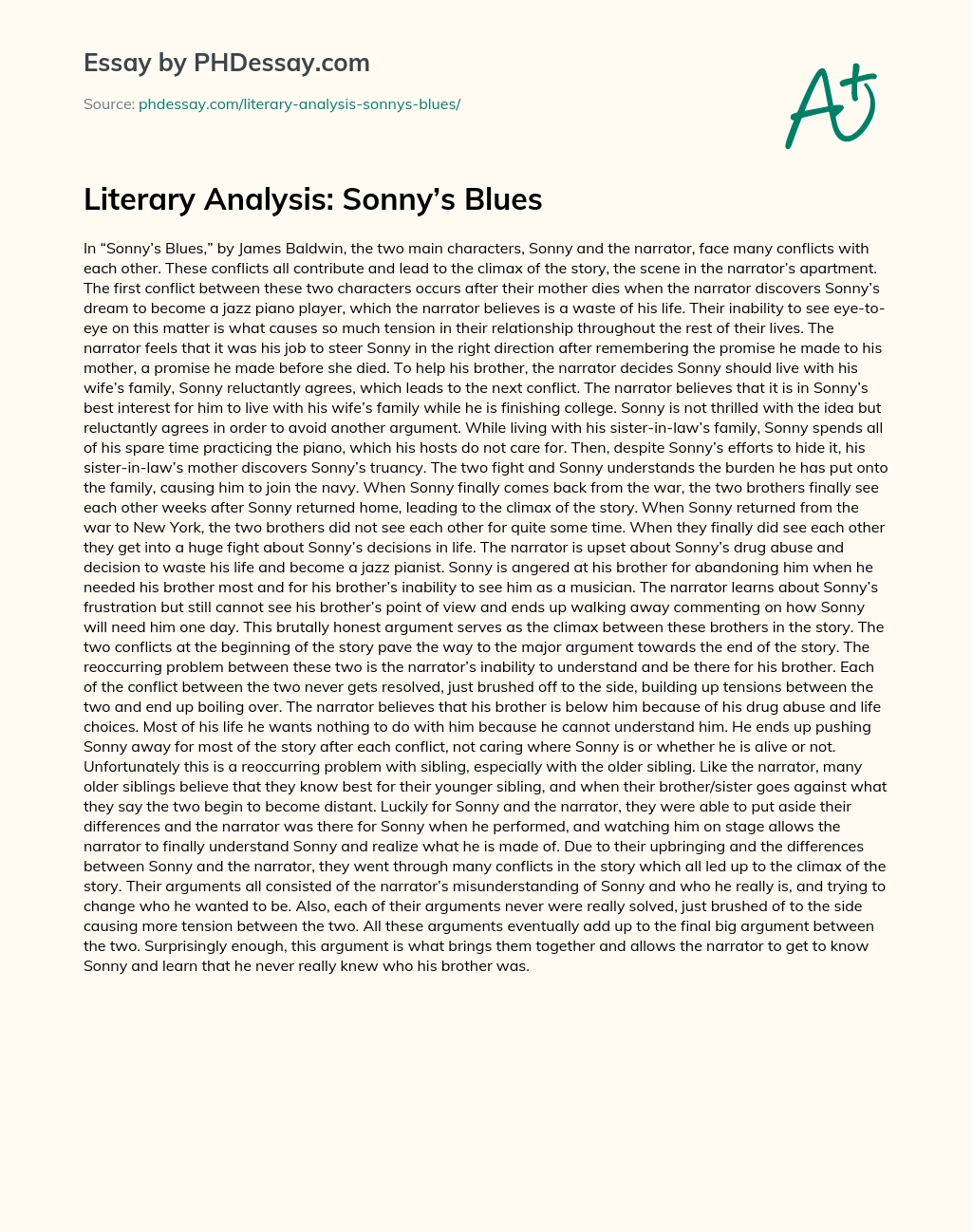Sonnys Blues Racism Rarely Referenced Directly but Its Pull Can Be Felt Continuously
In "Sonny's Blues," by James Baldwin, the two main characters, Sonny and the narrator, face many conflicts with each other. These conflicts all contribute and lead to the climax of the story, the scene in the narrator's apartment. The first conflict between these two characters occurs after their mother dies when the narrator discovers Sonny's dream to become a jazz piano player, which the narrator believes is a waste of his life. Their inability to see eye-to-eye on this matter is what causes so much tension in their relationship throughout the rest of their lives.
The narrator feels that it was his job to steer Sonny in the right direction after remembering the promise he made to his mother, a promise he made before she died. To help his brother, the narrator decides Sonny should live with his wife's family, Sonny reluctantly agrees, which leads to the next conflict. The narrator believes that it is in Sonny's best interest for him to live with his wife's family while he is finishing college. Sonny is not thrilled with the idea but reluctantly agrees in order to avoid another argument.
While living with his sister-in-law's family, Sonny spends all of his spare time practicing the piano, which his hosts do not care for. Then, despite Sonny's efforts to hide it, his sister-in-law's mother discovers Sonny's truancy. The two fight and Sonny understands the burden he has put onto the family, causing him to join the navy. When Sonny finally comes back from the war, the two brothers finally see each other weeks after Sonny returned home, leading to the climax of the story.
Order custom essay Literary Analysis: Sonny's Blues with free plagiarism report
GET ORIGINAL PAPER
When Sonny returned from the war to New York, the two brothers did not see each other for quite some time. When they finally did see each other they get into a huge fight about Sonny's decisions in life. The narrator is upset about Sonny's drug abuse and decision to waste his life and become a jazz pianist. Sonny is angered at his brother for abandoning him when he needed his brother most and for his brother's inability to see him as a musician.
The narrator learns about Sonny's frustration but still cannot see his brother's point of view and ends up walking away commenting on how Sonny will need him one day. This brutally honest argument serves as the climax between these brothers in the story. The two conflicts at the beginning of the story pave the way to the major argument towards the end of the story. The reoccurring problem between these two is the narrator's inability to understand and be there for his brother.
Each of the conflict between the two never gets resolved, just brushed off to the side, building up tensions between the two and end up boiling over. The narrator believes that his brother is below him because of his drug abuse and life choices. Most of his life he wants nothing to do with him because he cannot understand him. He ends up pushing Sonny away for most of the story after each conflict, not caring where Sonny is or whether he is alive or not. Unfortunately this is a reoccurring problem with sibling, especially with the older sibling.
Like the narrator, many older siblings believe that they know best for their younger sibling, and when their brother/sister goes against what they say the two begin to become distant. Luckily for Sonny and the narrator, they were able to put aside their differences and the narrator was there for Sonny when he performed, and watching him on stage allows the narrator to finally understand Sonny and realize what he is made of. Due to their upbringing and the differences between Sonny and the narrator, they went through many conflicts in the story which all led up to the climax of the story.
Their arguments all consisted of the narrator's misunderstanding of Sonny and who he really is, and trying to change who he wanted to be. Also, each of their arguments never were really solved, just brushed of to the side causing more tension between the two. All these arguments eventually add up to the final big argument between the two. Surprisingly enough, this argument is what brings them together and allows the narrator to get to know Sonny and learn that he never really knew who his brother was.

Did you know that we have over 70,000 essays on 3,000 topics in our database?
Cite this page
Explore how the human body functions as one unit in harmony in order to life
dickinsontorty1961.blogspot.com
Source: https://phdessay.com/literary-analysis-sonnys-blues/
0 Response to "Sonnys Blues Racism Rarely Referenced Directly but Its Pull Can Be Felt Continuously"
Post a Comment